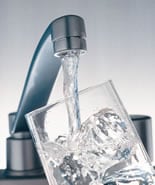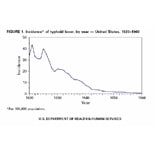NOTICE: This web page has been archived for historical purposes. Its content is no longer maintained, so information may be out of date and links may not work properly. For current Healthy Water features, please see the Newsroom, Features, & Observances page.
Drinking Water Week is May 3-9
The United States is fortunate to have one of the safest public drinking water supplies in the world. People use water every day for a variety of reasons, including drinking, recreation, agriculture, and industry.
In 2000, the United States alone used 408 billion gallons of water per day (1). This is the equivalent of approximately 1400 gallons of water per day for every man, woman, and child—and that is enough water to fill 14 standard-size bathtubs (2)! This amount includes water use that is direct (drinking, bathing, flushing the toilet, etc.) and indirect (watering the lawn, washing the car, commercial and industrial use, etc).
Each year, the American Water Works Association and an alliance of organizations, including the U.S. Environmental Protection Agency, sponsor Drinking Water Week to highlight the importance of tap water and the need to reinvest in our nation's drinking water infrastructure (3).
Water's Many Roles
Water plays a critical role in the success of a society, from meeting the basic public health needs of providing potable water and sanitation to supporting agricultural and other economic activities. Water also provides a range of societal functions and ecological services such as fire control and habitat protection. Access to safe drinking water lowers morbidity and mortality rates by protecting the population from waterborne diseases caused by viruses, bacteria, and other pathogens. One hundred years ago, life expectancy in the United States was only 47 years, in part due to potentially fatal water-borne diseases like cholera and typhoid fever that can be transmitted through drinking water. Today we have one of the safest drinking water supplies in the world, in large part due to disinfection and treatment of our drinking water.
History of Disinfection
During the past century, many improvements in the health and prosperity of the U.S. population can be attributed to improvements in water quality. In 1908, researchers Chick and Watson developed what would later be known as Chick's Law. Chick's Law describes the length of time and concentration of disinfectant needed to kill germs in water (4). Through her research, Chick determined that as contact time between microorganisms and disinfectant increases, the number of microorganisms in water decreases, thereby showing that a disinfectant can be effective in killing potentially harmful microorganisms in water. This monumental discovery quickly paved the way for researchers and scientists to promote widespread disinfection of drinking water, which played a critical role in improving drinking water quality in the United States.

Clean drinking water is one of the world's most precious resources.
In 1908, Jersey City, New Jersey was the first U.S. city to begin routine disinfection of a municipal drinking water supply (5). Over the next decade, thousands of cities and towns across the United States followed suit in routine disinfection of their drinking water. The incidence of waterborne diseases, such as cholera and typhoid, dropped dramatically, leading to a decrease in overall morbidity and mortality from waterborne diseases in the American population. For example, in 1900, there were approximately 100 cases of typhoid fever for every 100,000 persons living in the United States. By 1920, cases had decreased to 33.8 per 100,000 persons (6). In 2006, the rate had declined to 0.1 per 100,000 persons (only 353 cases) and approximately 75% of these cases occurred among persons following international travel (7, 8). This decrease in waterborne illness can be credited to advances in public health, including the implementation of drinking water disinfection in community water systems, one of the great public health achievements of the 20th century (9).

Incidence of Typhoid Fever, 1920-1960. With the implementation of disinfection methods for drinking water, there has been a drastic decline in cases of typhoid fever in the United States. Image Credit: Robert Tauxe. Click to view larger chart.
Today's Disinfection
Over the years, many sources of water pollution have been reduced; however, treatment of source water to remove or kill disease-causing contaminants is critical to the provision of safe drinking water. Contamination of drinking water supplies can occur at multiple points, including in the source water, through inadequate water treatment, in storage tanks, and in drinking water distribution systems.
Potential sources of water contamination include naturally occurring chemicals and minerals (e.g., arsenic, radon, uranium), local land use practices (e.g. fertilizers, pesticides, agricultural operations), manufacturing processes, sewer overflows, and malfunctioning wastewater treatment systems (e.g., septic systems). Public drinking water systems use various methods of water treatment to provide safe drinking water for their communities. Today, the most common steps in water treatment used by community surface water systems include flocculation, sedimentation, filtration and disinfection. A variety of technologies can be used in each of these steps. For example, sand, gravel, activated charcoal, and membranes can be used for filtration. Chlorine, ozone and ultraviolet radiation can be used as disinfectants (5). Water may be treated differently in different communities depending on the quality of the water that enters the treatment plant. Typically, surface water requires more treatment and filtration than groundwater because lakes, rivers, and streams contain more contaminants than groundwater.
The presence of contaminants in water can lead to adverse health effects, including gastrointestinal illness, reproductive problems, and neurological disorders. The US Environmental Protection Agency (EPA) regulates drinking water quality in public water systems and sets maximum contaminant levels (or treatment technique requirements) for waterborne contaminants, including microbes, chemicals, and other pollutants. More information about the rules that protect public drinking water systems can be found on EPA's National Primary Drinking Water Regulations page.
Every water utility company is required to provide Consumer Confidence Reports (CCR) to their customers each year. These reports provide information on local drinking water quality, including the water's source, the levels of contaminants found in the water, and how customers can get involved in protecting their drinking water.
To find more information about public drinking water quality in general and about your local drinking water CCR, visit:
- CDC Healthy Water Web site
- Consumer Confidence Reports (CCR) (Environmental Protection Agency)
- What Contaminants May Be Found in Drinking Water? (Environmental Protection Agency)
- EPA — Office of Ground Water and Drinking Water (Environmental Protection Agency)
Private Wells
EPA regulations that protect public drinking water systems do not apply to privately owned wells. As a result, owners of private wells are responsible for ensuring that their water is safe from contaminants. Private wells should be checked every year for mechanical problems and cleanliness, and the water should be tested to detect the presence of coliform bacteria, nitrates, and any other contaminants of local concern. A local health department or water well systems professional can help provide technical assistance on water quality for existing wells and on proper construction of a new well.
To find more information on private groundwater wells and steps individuals can take to protect the quality of their private well water, visit:
- CDC Private Well Owners
- Private Drinking Water Wells (Environmental Protection Agency)
A Global Need

Photo of a community well in Sierra Leone. Photo credit: Sharon Roy.
Today, hundreds of millions of people still do not have access to improved sources of drinking water (10), leaving people at risk for Water, Sanitation, and Hygiene (WASH) related diseases. Worldwide, there are 1.6 million deaths per year that can be attributed to unsafe water, poor sanitation, and lack of hygiene (11). The majority of these deaths occur among children younger than 5 years of age. In order to meet the United Nations' Millennium Development Goal to halve the proportion of people without sustainable access to improved drinking water and basic sanitation by 2015, an estimated 1.1 billion people will need to gain access to an improved water supply and 1.6 billion people will need to gain access to basic sanitation (accounting for expected population growth). Even if this Millennium Development Goal is reached by 2015, it will still leave 790 million people (11% of the world's population) without access to an improved water supply and 1.8 billion people (25% of the world's population) without access to adequate sanitation (12, 13).
To learn more about CDC's activities visit CDC Global WASH Programs and Projects. To learn more about water treatment and sanitation measures being undertaken in other countries around the world, visit the Global Health and Education Foundation.
Looking into the Future
Although the United States has one of the safest drinking water supplies in the world, new challenges, such as aging drinking water infrastructure, climate change impacts on water resource availability, chemical contamination of water sources, and the emergence of new ways to obtain and use water (e.g. water reuse, grey water, desalination), will require us to remain vigilant to protect all aspects of our water supply. Advancements and innovation in science, conservation of water resources, and improvements in water safety regulations will ensure that communities continue to receive safe drinking water.
More Information
- Healthy Drinking Water
- Water-Related Environmental Public Health
- Index of Water-Related Topics
- Community Water Fluoridation
- Global Water, Sanitation, and Hygiene Program at NCEH
- Safe Water System
- International Emergency and Refugee Health Branch (IERHB)
- Surveillance for Waterborne Disease and Outbreaks Associated with Drinking Water and Water not Intended for Drinking – United States, 2005-2006
References
- US Geological Survey. Estimated use of water in the United States in 2000.
- Water Systems Council. Wellcare information for you about water conservation. [PDF - 4 pages]
- American Water Works Association. Drinking Water Week 2009.
- Haas CN. Disinfection. In American Water Works Association, Water quality & treatment: a handbook of community water supplies. 5th ed. New York: McGraw-Hill; 1999. p 14.22-14.30.
- US Environmental Protection Agency. The history of drinking water treatment. Available at www.epa.gov/safewater/.
- Centers for Disease Control and Prevention. Achievements in public health, 1900–1999: safer and healthier foods. MMWR 1999; 48(40): 905.
- Centers for Disease Control and Prevention. Summary of notifiable diseases- United States, 2006. MMWR 2008; 55(53): 17.
- US Census Bureau. Annual estimates of the population for the United States, regions, and states and for Puerto Rico: April 1, 2000 to July 1, 2007 (NST-EST2007-01).
- Centers for Disease Control and Prevention. Achievements in public health, 1900-1999: changes in the public health system. MMWR 1999; 48(50):1141-1147.
- World Health Organization and UNICEF. Progress on Drinking Water and Sanitation – Special Focus on Sanitation.
- UN Millennium Project. Health, Dignity, and Development: What Will it Take?
- The United Nations. Millennium Development Goals report 2007.
- Joint Monitoring Programme. Millennium Development Goals assessment report 2006.
Get email updates
To receive email updates about this page, enter your email address:
Contact Us:
- Centers for Disease Control and Prevention
1600 Clifton Rd
Atlanta, GA 30333 - 800-CDC-INFO
(800-232-4636)
TTY: (888) 232-6348 - Contact CDC–INFO
 ShareCompartir
ShareCompartir
 May 3–9, 2009 is Drinking Water Week. Each year, the American Water Works Association and an alliance of organizations, including the U.S. Environmental Protection Agency (EPA), sponsor Drinking Water Week to highlight the importance of tap water and the need to reinvest in our nation's drinking water infrastructure.
May 3–9, 2009 is Drinking Water Week. Each year, the American Water Works Association and an alliance of organizations, including the U.S. Environmental Protection Agency (EPA), sponsor Drinking Water Week to highlight the importance of tap water and the need to reinvest in our nation's drinking water infrastructure.

